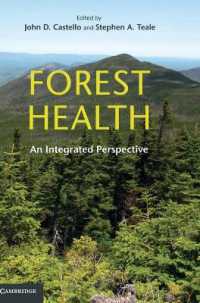- ホーム
- > 洋書
- > 英文書
- > Nature / Ecology
Full Description
Interpreting Agriculture in Museums and Historic Sites orients readers to major themes in agriculture and techniques in education and interpretation that can help you develop humanities-based public programming that enhance agricultural literacy. Case studies illustrate the ways that local research can help you link your history organization to compelling local, national (even international) stories focused on the multidisciplinary topic. That ordinary plow, pitch fork, and butter paddle can provide the tangible evidence of the story worth telling, even if the farm land has disappeared into subdivisions and agriculture seems as remote as the nineteenth century. Other topics include discussion of alliances between rural tourism and community-supported agriculture, farmland conservation and stewardship, heritage breed and seed preservation efforts, and antique tractor clubs. Any of these can become indispensable partners to history organizations searching for a new interpretive theme to explore and new partners to engage.
Contents
Foreword - Tom Kelleher
Part 1: Developing Interpretation with an Agricultural Perspective
Chapter 1 Interpreting Agriculture: Introduction to Terms and Themes
Chapter 2 Once a Field, now Suburbia: Interpreting Agriculture in Any Context
Chapter 3 Agriculture: Developing a Humanist Point of View
Chapter 4 Agriculture and Historical Thinking
Part 2: Agriculture in Time and Place: Research as the Foundation for Interpretation
Chapter 5 Documenting Agriculture in Two Dimensions: Background Research
Chapter 6 Documenting Agriculture in Three Dimensions: Artifacts
Research Summaries:
Chapter 7 You Can't Eat Gold: Agriculture in Early Colorado City, 1858-1867, Carol Kennis Lopez
Chapter 8 Changes in Corn-Belt Crop Culture: Iowa, 1945-1972, J.L. Anderson
Chapter 9 A Curator's Legacy, William S. Pretzer
Part 3: Thematic Studies to Inform Localized Agriculture Interpretation
Chapter 10 Roads and Bridges in Rural Agricultural Interpretation, Cameron L. Saffell and Debra A. Reid
Chapter 11 Horses, Harness, and Transport: Informing Interdisciplinary Interpretation, Barbara Corson, VMD
Chapter 12 Livestock in Agricultural Interpretation, Jonathan D. Kuester and Debra Reid
Chapter 13 Sex, Drugs, and GMOs: Crops and Agricultural Interpretation
Part 4: Developing Interpretation
Chapter 14 Interpreting Agriculture: A Multi-Step Sequential Process
Chapter 15 Case Study - Interpreting Rural Life in El Paso, Texas, Cameron L. Saffell
Chapter 16 Case Study: An Exhibit - Reaper: Nettie Fowler McCormick and the Machine that Built Tusculum College, Peter M. Noll
Conclusion
Appendix: Links to Useful Information








